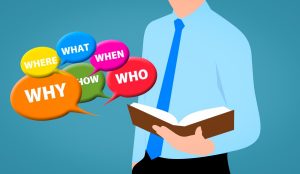Literature
61 How to Write a Book Review
 Book reviews are a way to think more deeply about a book you’ve read and to show your understanding of the author’s main theme(s) or purpose. A book review should be both informative (what the book is about) and persuasive (why a reader should or shouldn’t read this book). It should include both an objective summary and your personal comments and observations.
Book reviews are a way to think more deeply about a book you’ve read and to show your understanding of the author’s main theme(s) or purpose. A book review should be both informative (what the book is about) and persuasive (why a reader should or shouldn’t read this book). It should include both an objective summary and your personal comments and observations.
The following is an outline to help you prepare for and write your review. The review will include five paragraphs.
¶1 Introduction
The introduction paragraph provides basic information about the book and gives a sense of what your report will be about. Along with a standard essay introduction, include:
- Title and Author
- Publication information: publisher, year, number of pages
- Genre
- Brief description of characters
- Brief plot summary (1-3 sentences)
Body Paragraphs
There are two main sections for this part. The first is an explanation of what the book is about (summary). The second contains your opinions about the book and how successful it is (evaluation).
¶2 Summary
For fiction or other creative writing:
- Provide brief descriptions of the setting, the point of view (who tells the story), the main character(s) and other major characters. If there is a distinct mood or tone, mention that as well, for example gloom and doom, joyful, calm, tense, mysterious, etc.
- Give a short, objective plot summary. Provide the major events and the book’s climax and resolution.
Evaluation
In this section you explore and question the book in two paragraphs. Write your own opinions, but be sure to explain and support them with examples from the book.
¶3—Illustration/Expository paragraph
Define or explain the main literary element/s in the book. Some questions you might want to consider: Were you most struck by character, such as development or use of character types? Was the use of setting most memorable to you? Do you feel that conflict drove the plot? Which of the elements of Literature you have studied was most pivotal in this book?
¶4—Persuasive paragraph
Express whether a reader should or shouldn’t read this book. Some questions you might want to consider:
- Did the author achieve his or her purpose? For example, if this is a mystery story, did you feel the mystery and tension?
- Is the writing effective, powerful, difficult, beautiful?
- What are the strengths and weaknesses of the book?
- What is your overall response to the book? Did you find it interesting, moving, dull?
- Would you recommend it to others? Why or why not?
¶5—Conclusion
Conclude by pulling your thoughts together into a standard conclusion paragraph. You may also want to say what impression the book left you with or highlight what you want your reader to know about it.
Media Attributions
- “Who, What, Where” by mohamed hassan is licensed under a CC-0 Public Domain Licence.

